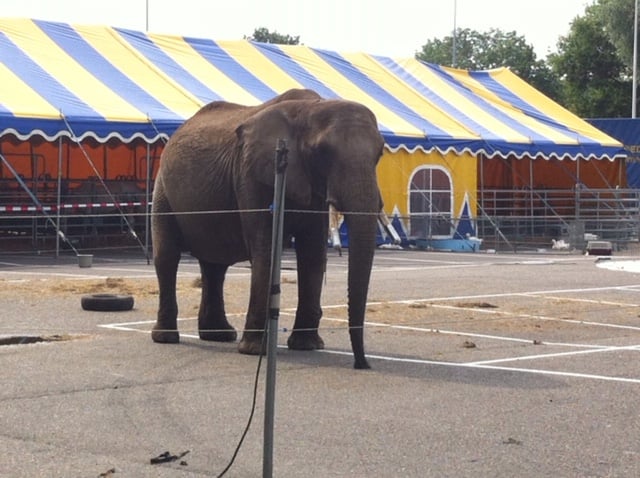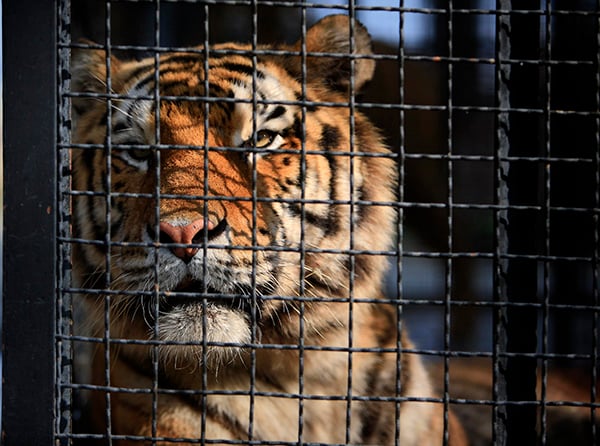
While some of the major circuses around the world have folded up their tents, smaller circuses still thrive, causing wild animals to suffer.
Let’s get this out of the way: I come from a circus family. Two of my great aunts were famous aerialists in the now-shuttered Ringling Bros. and Barnum & Bailey Circus. My great uncle was an owner of Clyde Beatty Circus, which eventually merged and became known as Cole Bros. Circus before it packed up its tent. Both my great aunts and my great uncle were memorialized in the Circus Hall of Fame.
So why do I adamantly oppose circuses? I don’t. I just oppose circuses that use animals for entertainment. Here’s why.

1. Elephants are cruelly trained to perform tricks.
Numerous undercover investigations into animal circuses such as Ringling, Carson & Barnes, and Cole Bros. Circus found that elephants are continuously beaten during training sessions. One of the cruelest videos on the internet today is an investigation into Tim Frisco, a former elephant trainer whose sons went into the family business. In the video, Frisco screams at his staff to “hurt ‘em, don’t touch ‘em, make ‘em scream … when you hear that screaming, then you know you got their attention.”
Unfortunately, this kind of abuse is common when it comes to training elephants for entertainment. To be trained for circus tricks, elephants are torn from their mothers’ sides at an early age and are inflicted with pain. The babies have ropes tied around their legs and forced into unnatural positions all while being painfully jabbed with bullhooks or other sharp instruments. During performances, the elephant trainers carry bullhooks, often concealed from the public’s eye but visible to elephants, to remind the animals of human dominance.
2. Big cats in circuses spend most of their time in cages so small, they can barely turn around.
Former owner of the now-defunct Ringling Brothers, Henry Ringling North stated in his book, The Circus King, that tigers and lions are “chained to their pedestals and ropes are put around their necks to choke them down. They work from fear.” The big cat expert Jay Pratt observed multiple Ringling Brothers shows and concluded that performing big cats showed body language indicating stress, fear, and psychological duress. This is common in all circuses.
When big cats are not performing, they are crammed into cages so small that they can just barely turn around. This leads to sores from lying on hard cage floors and abnormal behavior—such as constant pacing or overgrooming—to cope with their stressful environments.
3. Every major American circus that uses animals has been cited for animal welfare violations.
Ringling, Cole Bros., Carson & Barnes, Shriners, and UniverSoul are some of the many circuses in the United States that had or currently have wild animals. All have been cited for failing to provide minimal standards of care set forth by the Animal Welfare Act. Some citations include failure to provide access to fresh food and water, sufficient space, and adequate veterinary care.
4. Animals are inhumanely confined for most of their lives.
Wild animals used in circuses spend nearly 96 percent of their entire lives in chains or cages. They spend their lives being carted from town to town, state to state, for 11 months out of the year.
Often, the boxcars wild animals travel in have no climate control, meaning the animals endure extreme weather conditions. They are also forced to eat, sleep, and defecate in the same space. The transport cars are often in poor shape, and circuses have been repeatedly cited by the USDA for trailers with splintering wood and sharp, protruding metal pieces that could hurt the animals.
Due to long hours standing on hard surfaces and lack of appropriate exercises, the leading causes of death among captive elephants are foot infections and arthritis.
5. Captive elephants in the US have been diagnosed with TB.
Elephants in captivity can carry the human strain of Tuberculosis (TB). Those in circuses are particularly at risk due to consistent exposure with infected humans or other elephants. Other factors including stress caused by painful punishment, extreme confinement, poor nutrition, and consistent transport can weaken an elephant’s immune system, making it easier to contract the virus.
Some elephants who did not exhibit symptoms were confirmed positive during necropsies, possibly infecting other elephants with the disease.

6. Circus animals frequently escape.
In 2004, a tiger named Apollo escaped a Cole Bros. Circus and ran through the busy New York City borough of Queens. Apollo ran through a crowded park during a busy Saturday and then caused multiple accidents on the Jackie Robinson Parkway, resulting in several severe injuries of drivers. Just nine years earlier, elephants escaped from the same circus in Queens, causing a panicked stampeded that injured a dozen people.
One of the most heartbreaking escapes happened in Hawaii in 1994. Tyke, an African bush elephant, killed her trainer, seriously injured her groomer, and ran through the streets of Honolulu before being killed by local police. The entire ordeal was caught on camera, including Tyke’s last moments where she succumbed to nerve damage and brain hemorrhages from 87 bullets.
While these extreme cases might seem like from a distant time, zebras, elephants, tigers, camels, and other animals have been reported by local news outlets escaping the circus in just the past few years. Some escaped animals have even been killed by cars while running through busy areas.
7. Major states and cities have banned wild animal circuses.
Because animal abuse in circuses is so prevalent, local governments have already banned or restricted the use of wild animals in traveling acts in Los Angeles, San Francisco, Pasadena, Santa Ana, Huntington Beach, Marin County, and New York City, along with states California, Hawaii, New Jersey, and dozens of countries around the world.
In 2019, World Animal Protection was proud to be one of many organizations supporting and working on California’s legislation to ban the use of wild animals statewide. In the summer of 2024, Massachusetts became the 11th state to ban wild animals in circuses.
8. There are still circuses in the US that operate today.
When Ringling closed up shop in 2017, other circuses quickly folded as states and major cities banned the use of bullhooks, whips, or the use of wild animals for entertainment. However, there are still circuses in business today that travel around the country with wildlife, including Loomis Bros Circus, Jordan World, Carden International, Royal Hanneford, and Carson & Barnes.
9. Animal-free circuses are just as fun!
Animal-free circuses tour the United States just like those with wild animals do. World Animal Protection encourages everyone to choose animal-free circuses for entertainment and to research any circus before attending.
Some circuses that travel around the country without animals include Circus Smirkus, Circus Vargas, and the newly animal-free Kelly Miller Circus.
Wildlife are not here to entertain us, and that includes circus animals. In addition to only visiting animal-free circuses, you can learn how to be a wildlife-friendly traveler and ensure you’re choosing ethical entertainment venues.